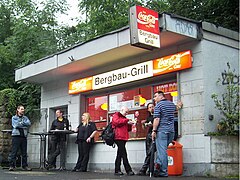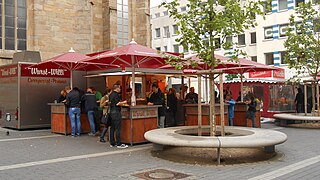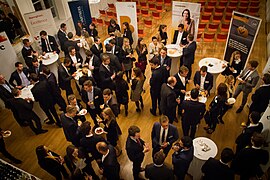High table
A bar table , often bistro table and rarely also bar table , snack table or party table is a piece of furniture from the group of tables . It consists of a mostly round plate, which rests on a support, which is mainly designed as a central standpipe - with a heavy base plate or multi-armed base frame - or as a central tubular frame. Depending on their purpose, there are different versions of high tables, whereby they are often designed for use in outdoor catering . Some of them can be folded up to save space; There are also height-adjustable models.
Bar tables are mostly used to consume food and / or drinks while standing or to bring objects, devices and other operated elements to an elevated position so that they can be accessed more easily. In addition, they serve as a "starting point and meeting point for communication and meeting purposes" etc.
history
In the 18th century, small-format special tables were created that initially served the needs of the upper class for play, sewing, reading and writing purposes. This also included higher tables with mostly round, sometimes also polygonal tops, which were initially only used as “pedestals” for decorative objects in the home such as large vases, small sculptures, etc.
In the 19th century, high tables were developed from this , which were soon used in the catering industry because they do not have seating or only require bar stools and thus save space. They became popular in (small) restaurants , bars and cafes as well as in bistros , which gave their name to the genus of typical bistro tables . Bistro tables are sufficient to set down drinks glasses and possibly ashtrays etc. In addition, they ensure a suitable ambience.
function
A high table can be used to eat or work while standing, it can be used for meeting purposes by two or more people and it can serve as a storage space or just for decoration purposes. Because they are mainly used when standing, high tables are higher than usual tables and are usually not equipped with chairs , but sometimes they are also used together with high-legged bar stools or bar stools while sitting.
Depending on the location and occasion, standing tables often serve precisely defined purposes:
- Bar tables are the hallmarks of snack stands (also known as snack bars , Austrian buffets or sausage stands , Swiss take-away ) and are used to eat mainly street food while standing. In addition, they can often be found in snack bars - often called snack halls or in Austria snack bars -, sometimes also in bistros , ice cream parlors and kiosks etc.
- At receptions ("standing receptions"), high tables are primarily used to consume drinks and sometimes small dishes such as finger food or canapés while standing, but are often only used to set down empty glasses and used plates and serviettes, etc. used. Often they are in this application with slipcovers equipped (table covers), in order to "optically enhance".
- At meetings , congresses, seminars and similar events, standing tables are often used in anteroom or in the back or side of the room and thus mark break areas in which the event participants can drink refreshments and snacks as well as meet and chat with one another. Sometimes they are provided with table covers.
- In theaters , concert halls , cinemas , museums , exhibition and assembly buildings, standing tables are often used to ( partially ) furnish foyers and break areas, etc. Sometimes they are equipped with table covers.
- In trade and business , especially in the service sector as well as at trade fairs etc. or at political or civil society information stands , standing tables are often used as contact points for customer contacts, advice and advertising or for information purposes etc.
- Examples of the use of high tables
Standing tables at a snack stand in Bochum
Larger angular bar tables with awnings , here at a snack stand in Dortmund
Standing tables, here at the “Get Together” and a champagne reception at a professional contact exchange
Standing tables with bar stools , here in the foyer of a cabaret theater in Munich
construction
A high table mostly has only one table leg in the form of a central stand pipe or a central tubular frame. A statically determined support to reach the foot is often the case with a central upright tube ( "Table Column") in the form of a heavy and large enough foot plate - a so-called plunger foot formed -. Alternatively, there is - as usual in use at the central tube racks - Fußausbildungen in the form of a multi-arm pedestal ( " four-star ") consisting Kippsicherheitsgründen is usually four or fünfarmig formed. Sometimes there are high table variants with a bundle-shaped tubular frame, in which three or more tubes are attached to the underside of the table top in the outer edge area (and not in the middle).
The tabletop of high tables is mostly round; Square table tops are rarely found. It can consist of any solid material, most commonly metal ( stainless steel sheet , sheet steel with mostly powder coating as rust and surface protection, aluminum ) or wood (often beech ) or wood-based material such as MDF (sometimes with plastic coating). There are also table tops - or complete high tables - made of glass fiber reinforced plastic (GRP or “fiberglass”).
Metal materials such as stainless steel, steel or aluminum are mainly used for the legs of high tables. As far as steel pipes and parts are concerned, these are usually powder-coated or partly chrome-plated for the purpose of corrosion and surface protection . Wood is rarely used in the leg constructions of high tables and is mostly only found in custom-made products by carpenters or in designer creations.
Bar tables are usually around 105 to 110 cm high; the table tops are around 60 to 80 cm in diameter in the round version and around 60 x 60 cm in the square version. There are also height-adjustable models, in which the table height can be reduced to around 70 cm, thus enabling the tables to be used while seated together with conventional (outdoor catering) chairs . In some cases, the high tables can be folded up completely for space-saving storage or the table tops can be folded (up) vertically, and in some cases the legs of tubular frames can also be folded in to the side.
In addition, there are high tables ("bar tables") with elongated and mostly rectangular table tops or in the form of so-called bridge tables , especially for bar equipment . The light cubes (luminous decorative elements and furniture made of plastic) that have become popular in the exhibition and event area as well as in bars, discos and the leisure hotel industry are sometimes also offered by retailers that are designed as high tables. For use in outdoor catering and at snacks and kiosks, etc. there are sometimes high tables with an integrated device for inserting a parasol ; In addition, there are some models with integrated waste bins on the market.
- Examples of different designs
reception
Tables are commonly identified as "objects of everyday western culture ", with the high table or bistro table in particular being used as a " metaphor and practice for designing places for thinking and meeting". Communication and marketing experts propagate “the standing table” as a suitable starting point and meeting point “for creative exchange and the development of a common solution”, since it “ best [promotes] participation [of the discussion participants] and informal interactions with one another”. In trade and business, especially in the service sector, standing tables are often used in customer halls, contact and advice zones and at trade fair stands, etc., because they are “good for communication” and the “inhibition threshold for making contact” is much lower than in, for example Advice booths or individual offices. For example, while a " lectern with a screen [...] emphasizes a formalized lecture character" at lecture events, a standing table instead creates "a relaxed atmosphere".
(Standing) tables with a round top combined the symbolism of the round table - at which, in its original meaning, “people come together who have the same disposition in the matter that brings them together” and at which “speeches become informal speaking [ …] Walk ”- according to the cultural historian and philosopher Hajo Eickhoff , with the informal, open use of the opportunity to get together with other, often strangers, while standing“ in an upright posture ”, which makes“ a table of equality and concession ”.
literature
- Office-work.net (Ed.): Office-work.net advice. Work tables, conference tables, management tables, standing tables, sitting tables . Haefner, Heidelberg 2007, OCLC 699269434 .
- Gert Kähler (texts): Furniture. Furniture . Ed .: Meinhard von Gerkan (= Gmp - Architects von Gerkan, Marg and Partner . No. 5 ). Jovis, Berlin 2007, ISBN 978-3-939633-21-1 (German, English, see: bistro table, round , bistro table, square ).
- Cornelia Fröschl: Architecture for the quick kitchen. Changing food culture . Koch, Leinfelden-Echterdingen 2003, ISBN 3-87422-654-9 , p. 13 .
- Fritz Spannagel : Furniture Making (1954). A specialist book for carpenters, architects, teachers and enthusiasts . Unchanged reprint of the 10th edition, Ravensburg, Maier, 1954. Schäfer, Hannover 2002, ISBN 3-87870-666-9 , p. 134–144 ( The construction of tunnels for chairs, stools and tables ).
Web links
Individual evidence
- ↑ a b Karin Martens-Schmid: Where coaching is at home. Consultation rooms and their design in a cultural and social context with photographs by Olaf Pascheit . Springer, Wiesbaden 2016, ISBN 978-3-531-18272-8 , pp. 160-167 .
- ↑ See: Karl Weidinger: Of table, chair and bed. Compendium: On the history of the most common furnishings . In: wienerzeitung.at . May 11, 2001, accessed October 31, 2018 .
- ↑ See: Hannelore Schlaffer : Die City. Street life in the planned city . To Klampen, Springe 2013, ISBN 978-3-86674-188-1 , p. 64 .
- ↑ See: Elisabeth Naumann: Kiosk. Discoveries in an everyday place. From a pleasure pavilion to a small temple of consumption . Jonas, Marburg 2003, ISBN 3-89445-322-2 , p. 115, 128, 158 .
- ↑ a b c Cf. Falk Trunz: Operatives Event Management. The ultimate short guide for event managers . Tredition, Hamburg 2016, ISBN 978-3-7345-0079-4 .
- ^ A b Mike Brüning: Trade fairs and exhibitions as an instrument in the marketing mix . Diplom.de, Hamburg 2013, ISBN 978-3-8324-5610-8 , pp. 36, 50 (online resource; dissertation, diploma thesis, Berlin University of Applied Sciences, 2000).
- ↑ See: Eckhard Heyelmann u. a .: Furniture in detail. From the schools for wood and design in Garmisch-Partenkirchen . Deutsche Verlags-Anstalt, Munich 2008, ISBN 978-3-421-03618-6 , pp. 17 .
- ↑ See: Meinhard von Gerkan (Ed.): Wood. Furniture. Jovis, Berlin 2007, ISBN 978-3-939633-21-1 (German, English; see: bistro table, round, bistro table, square ).
- ↑ a b Cf. usual offer of the trade.
- ↑ a b Guido Englich, Burkhard Remmers: Planning manual for conference and communication rooms. Conference. Excellence . Ed .: Wilkhahn . Wilkening and Hahne, Basel 2008, ISBN 978-3-7643-8682-5 , pp. 143, 214 .
- ↑ Hajo Eickhoff: The table . In: Bauwelt . Issue 17, 1993, ISSN 0005-6855 , pp. 879 ff .











